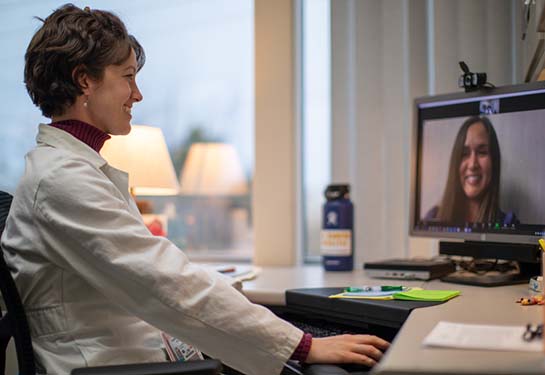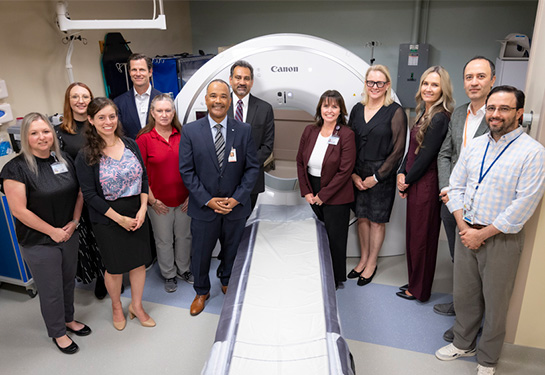Increasing access to health care by investing in telehealth
UC Davis Health is looking to the future of health care and expanding access to telehealth visits to reach more patients in more places.
According to a new study by Epic Research and the Kaiser Family Foundation, early in the pandemic 13% of outpatient visits were conducted via telehealth. Over the last six months, the percentage of telehealth visits has decreased to 8% but remains elevated over pre-pandemic levels.
“Early in the COVID-19 pandemic, telemedicine was a way patients could connect with their health care team and get routine care without coming to a hospital or clinic,” said Michael Condrin, chief operating officer for ambulatory care. “Two years into the pandemic, telehealth has proven to be a safe and effective way for many populations, including vulnerable communities, to access care.”
This year, UC Davis Health estimates 19% of its patient visits will be done via telehealth.
“With this increased access to care, and the good quality outcomes we are seeing for patients, we are working to expand our telehealth options and bring more services to patients, making it even more convenient and easier to access needed services,” Condrin added.
Impact of the COVID-19 pandemic on telehealth
Early in the COVID-19 pandemic, telemedicine experienced rapid growth as patients and providers looked for ways to safely access and deliver health care.
In early March 2020, UC Davis Health went from having just 23 telehealth visits per day to more than 1,000 video visits between providers and patients daily. Throughout the month, the Medical Center averaged nearly 1,100 telehealth visits a day.
“At first we were just trying to get people to try it,” said Mark Avdalovic, professor of clinical medicine and medical director of ambulatory practice innovation. “Then suddenly everyone was getting up to speed, and now we’re trying to optimize what we do well and improve what we can do better.”
“We want the experience for patients to be excellent,” he said. “We’re looking at how to improve the technology and how to connect even better with our patients on a personal level.”
With this increased access to care, and the good quality outcomes we are seeing for patients, we are working to expand our telehealth options and bring more services to patients, making it even more convenient and easier to access needed services.” —Michael Condrin
Telehealth care at UC Davis
Even before the early days of the COVID-19 pandemic, UC Davis Health was working to expand digital health offerings.
Telehealth at UC Davis began as a tele fetal monitoring connection with Colusa Community Hospital in 1992 and evolved to become the Center for Health and Technology in 2000. The telehealth program was established to reduce health disparities by bringing clinical care and educational resources directly to communities in need of specialized services.
“We've led a number of monumental initiatives focused on improving telehealth technology, equipment access, broadband networks and education for medical students interested in caring for rural communities,” said James Marcin, director of the Center for Health and Technology.
UC Davis Health’s recent telehealth initiatives include:
- Express Care Platform: Allows patients to connect with a UC Davis Health physician for same-day and extended-hours video visits using a smartphone, tablet or personal computer. Patients can discuss urgent care issues such as flu-like symptoms, cough, urinary tract issues, GI problems, joint pain, and more. The service is the largest direct-to-consumer academic telemedicine service in California.
- UC Davis Pediatric Telemedicine Program: One of the first programs of its kind in the nation to provide physicians and patients with real-time remote consultation and evaluation though interactive, high-definition video and audio communication. This enhanced video technology allows UC Davis to offer 24/7 expertise to remote health care providers, without the need to transfer a patient to UC Davis Children’s Hospital.
- ACTIVATE: Aims to reach populations who are vulnerable to the worst outcomes of the COVID-19 pandemic with the technology, skills, and connections they need to access and utilize health care services.
- Provider-to-Provider Telehealth: Connects physicians and their patients with UC Davis Health specialists. Since its inception, the program has provided real-time consultation services in nearly 50 specialties. More than 200 clinics and hospitals, typically located in rural areas, have benefitted from the innovative program.
- Digital Health Equity Program: Supports the creation of a regional digital public health platform to improve access to and continuity of care for vulnerable populations in the Sacramento area and the northern California region. This project expands UC Davis Health’s ability to partner and coordinate with federally qualified health centers to bring more services to vulnerable patients and community members and make access to health care easier. The program also works with community organizations to join this digital platform, to further improve care coordination and access to non-health services.
“We are incredibly proud of these programs, which have established UC Davis Health as the statewide leader in telemedicine and digital health,” Condrin said. “They have had a profound impact on patient care in our community and continue to build on the medical center’s long history of reaching out to the most vulnerable, underserved populations in the region.”





